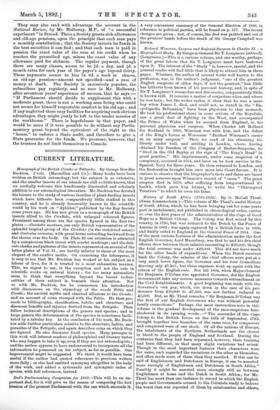CURRENT LITERATURE.
Monograph of the British Cicada or Tettigidx. By George Dowdier Buckton. 2 vols. (Macmillan and Co )—Many books have been written on British entomology, but the subject is so extensive, and the smaller insects of our islands are still so little known, that we cordially welcome this handsomely illustrated and scholarly addition to our entomological literature. Mr. Buckton has devoted his leisure to the study of various families of plant-feeding insects which have hitherto been comparatively little studied in this country, and he is already favourably known to the scientific world by his work on "Aphides," published by the Ray Society some years ago. He has now given us a monograph of the British insects allied to the Cicadid,w, with enlarged coloured figures. Prominent among these are the species figured in the first two plates :—Cicadetta montana, our only British representative of the splendid tropical group of the Cicadidw (in the restricted sense) ; and Centrotus cornutus, with great horns extending backward from the thorax over the body. On Plate 22 our attention is attracted by a conspicuous black insect with scarlet markings ; and the deli- cate shades and patterns of the insects represented on several of the latter plates of Vol. II., are hardly inferior to those of the most elegant of the smaller moths. On examining the letterpress, it is easy to see that Mr. Buckton has worked at his subject as a labour of love, for it is treated in a most exhaustive manner. This, we regret to say, is the exception and not the rule in scientific works on natural history ; for too many naturalists seem to think that everything beyond the barest techni- calities of their subject is beneath their attention. Not so with Mr. Buckton, for he commences his introduction with discussions on the etymology of the words Tettix and Cicada; the ancient myths and classical allusions to the Cicada; and an account of coins stamped with the Tetti.v. He then pro- ceeds to bibliography, classification, habits, and structure, and discusses benefits and injuries derived from the Tettigidn. Then
follow technical descriptions of the genera and species; and in large genera the determination of the species is sometimes facili- tated by a tabular key. At the conclusion of his work, Mr. Buck-
ton adds further particulars relative to the structure, habits, and parasites of the Tettigidze, and again describes coins on which they
are figured. He also discusses fossil species. Many passages in this work will interest readers of philosophical and literary tastes who may happen to take it up, even if they are not entomologists ; and the author appears to have endeavoured to incorporate all the information he possessed on his subject, as far as possible. One improvement might be suggested. We think it would have been useful if the author had quoted references to previous writers more fully; or else had omitted synonymy altogether in the body of the work, and added a systematic and synonymic index of species, with full references, instead.


































 Previous page
Previous page